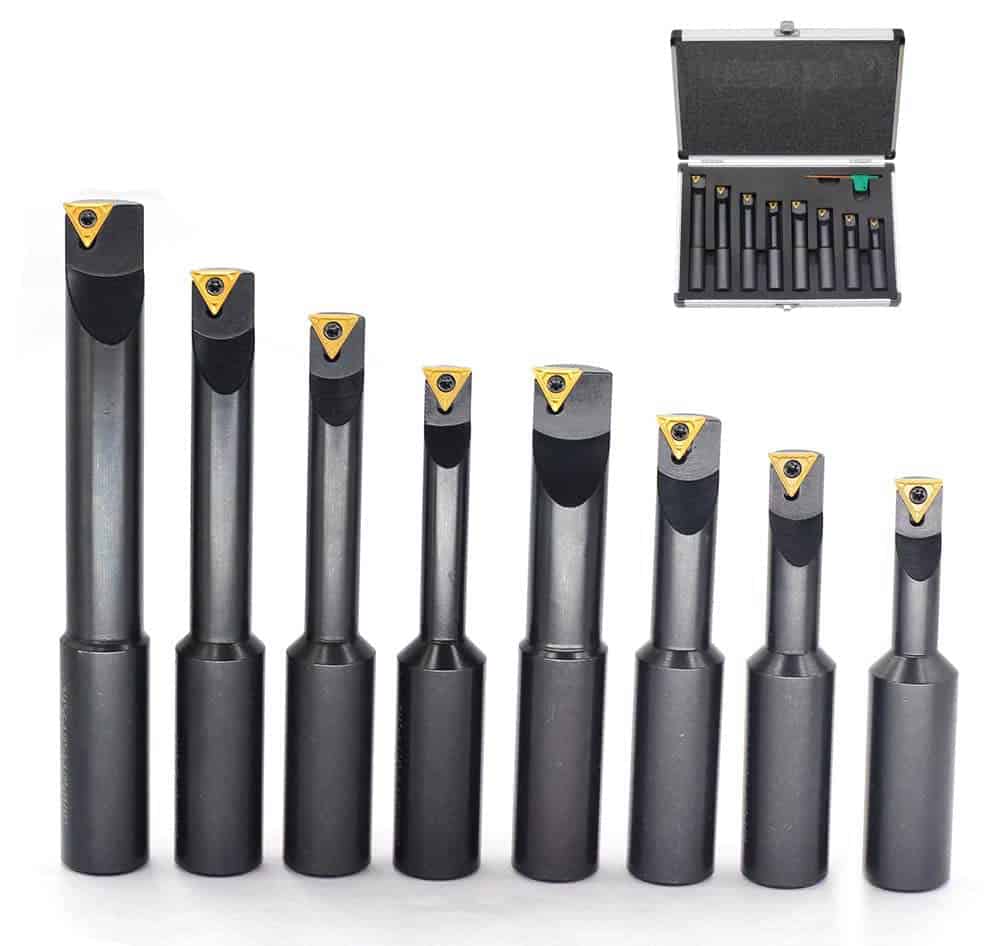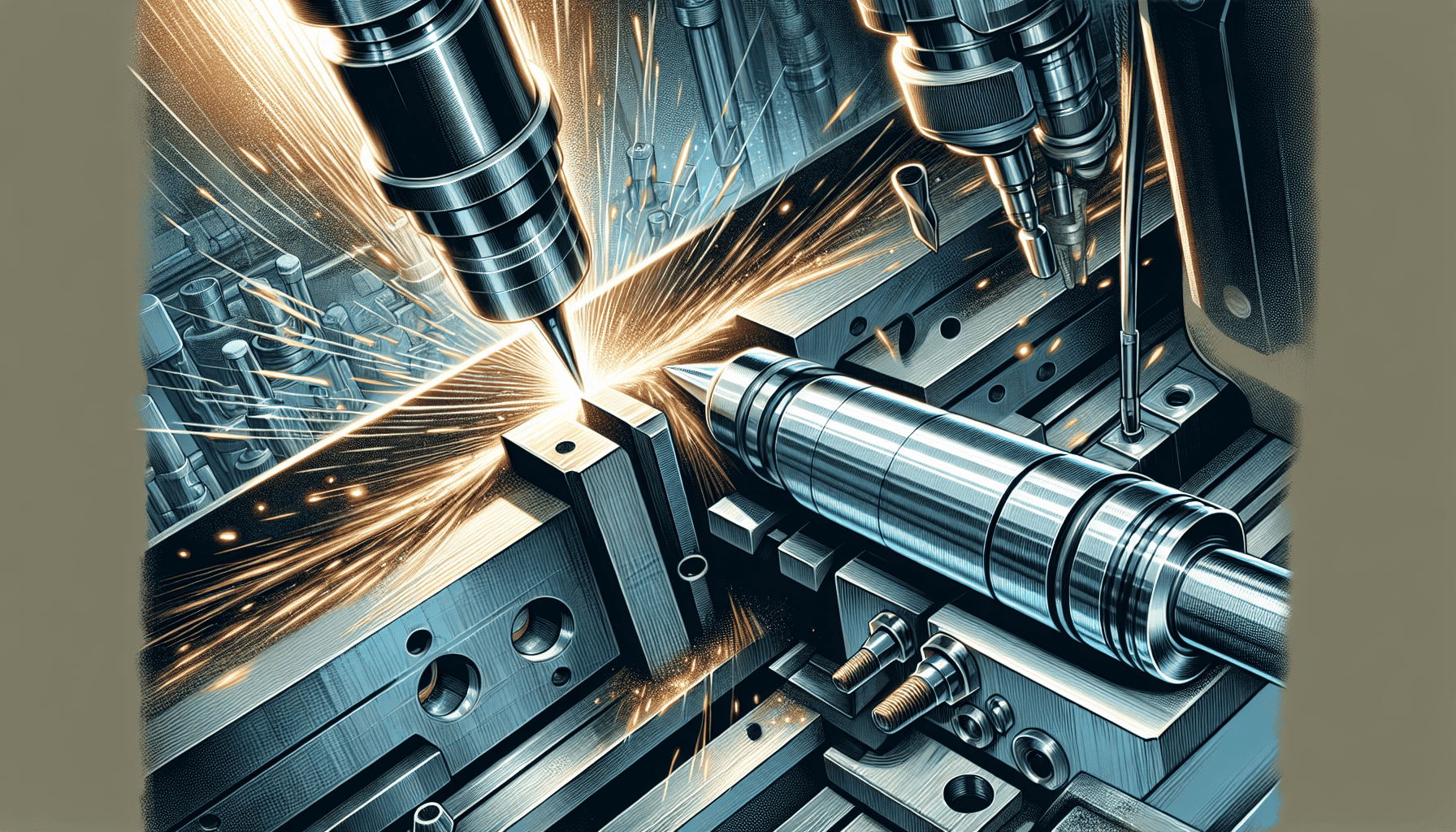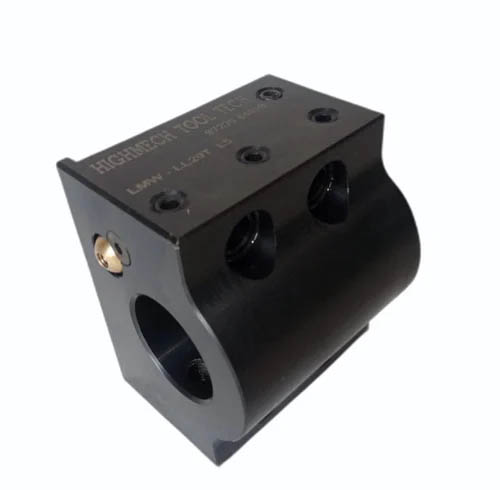A boring bar is crucial in machining for enlarging existing holes with precision. This guide covers different types of boring bars, essential features, and tips for selecting the right one for your lathe cutting tools needs.
Key Takeaways
- Solid carbide boring bars are preferred for precision machining due to their exceptional rigidity, durability, strength, and precision, making them indispensable in industries requiring high accuracy.
- High-performance boring bars often feature advanced designs like helical back rake flutes, square necks, vibration dampening, and coolant-through technology to enhance accuracy, chip flow, and thermal management, reducing downtime and increasing efficiency.
- Maintaining and using boring bars effectively involves careful selection, proper maintenance, and the use of appropriate accessories such as boring heads and mounting tools to ensure stability and precision in machining operations.
Solid Carbide Boring Bars Overview

Solid carbide boring bars stand as the pinnacle of tooling for precision machining. Renowned for their exceptional rigidity and durability, these tools retain their sharpness even when facing the toughest metals. But it’s not just about toughness; they are engineered to be 70% stronger than their round neck counterparts, ensuring they can withstand the stresses of rigorous machining processes without breaking a sweat.
The magic lies in the tip, ground to a sharp corner that promises unmatched precision. Boring bars are the backbone of precision machining, tasked with enlarging pre-existing holes to exact dimensions with a superior surface finish. They’re the craftsmen’s paintbrush, turning rough sketches into masterpieces across various materials, and are pivotal in industries where accuracy is not just appreciated but required for the integrity of the final product.
Types and Uses of Boring Bars
HSS
Carbide
Coolant Through Solid Carbide Boring Bars
Dampened Boring Bars
Description
Boring Bars made of high speed steel.
Boring Bars made of Tungsten Carbide
Carbide Boring bars that have through coolant passages.
Carbide Boring Bars that include vibration dampening features.
HSS
Carbide
Coolant Through Solid Carbide Boring Bars
Dampened Boring Bars
Uses
Low end jobs that don’t involve too much bar overhang. HSS will deflect excessively if hung more than 3-4x their diameter.
General Purpose. Carbide can be hung up to 7-8x their diameter without excessive deflection
Used to improve surface finish and to faciliate chip clearance in deep bores. Also used for materials that are more difficult to keep cool such as stainless, nickel alloys, and titanium.
Use whenever vibration or machine chatter is hindering productivity. Longer length to diameter ratios are particularly prone to chatter.
High-Performance Boring Bars: Key Features
When it comes to high-performance boring bars, the material makes all the difference. Tungsten carbide, the material of choice, offers a level of rigidity, hardness and wear resistance that is virtually unparalleled. The thermal conductivity of carbide is another feather in its cap, efficiently whisking away the heat generated during machining. This means that the cutting edge remains sharp for longer, reducing the frequency of replacements and downtime.
Design is equally crucial. A high-quality boring bar should have the following design features:
- Helical back rake flute: enhances accuracy and chip flow
- Square neck: bolsters rigidity and minimizes tool deflection, ensuring precise and concentric holes
- Minimal deflection: allows for higher cutting speeds, increasing productivity and shortening machining time.
These bars are not just tools; they’re investments in precision and efficiency.
Coolant Through Solid Carbide Boring Bars

Coolant-through technology is a game-changer in the world of solid carbide boring bars. This innovative feature allows for coolant to flow directly through ports in the shank, providing excellent vibration resistance even when working with deep holes. Recommended for both finish and light-cut boring applications, these bars shine in their ability to achieve a superior surface finish, a testament to the solid carbide shank’s effectiveness.
The precision of these bars is further enhanced by the use of PVD coated cermet inserts with SF chip breakers, designed to ensure the surface of the metal bored remains impeccable. Coupled with a 95-degree approach angle for a 7-degree relief CCMT insert, the result is a drilled hole that is not only precise but also exhibits a remarkable finish.
Dampened Boring Bars

Dampened boring bars are your silent warriors in the fight against vibration. These bars come equipped with an internal damping system that’s specifically engineered for efficient deep hole finish boring. The damping system works instantaneously to quell chatter, ensuring better surface finishes and higher metal removal rates. Including a center through coolant supply only adds to their cutting prowess, making them a favorite in demanding sectors like aerospace and automotive manufacturing.
As the length-to-diameter ratio increases, so does the importance of vibration management. Modular in design, these dampened bars can be customized to meet the specific needs of deep boring operations. Whether you’re dragging the tool on the X or Y axes to create a slot or employing an up and down motion on the Z axis for a perfect circular hole, these bars ensure stability and precision.
Typical examples include Sandvik-Coromant's Silent Tools, Sumitomo's X-Bars, and Seco's Steadyline® Boring Bars.
Application and Use Cases
Viewing boring bars through the lens of their applications reveals their versatility and indispensability in both metalworking and woodworking. In the realm of metalworking, boring bars are the architects of precision, enabling the creation of holes with a level of accuracy and consistency that’s essential for high-quality manufacturing.
Woodworking applications, though perhaps gentler in nature, demand the same precision, and boring bars rise to the challenge, ensuring the integrity of each drilled hole that results.
Metal Boring

In metalworking, the lathe and the boring bar form an alliance that’s hard to beat. Imagine a symphony where the boring bar is the soloist, and the lathe is the orchestra, together creating a masterpiece within the stock material. Enlarging existing holes or crafting new ones with surgical precision, these tools can handle both circular and asymmetrical holes, moving deftly along X, Y, and Z axes to achieve the desired result.
The versatility of these boring tools is further displayed in their ability to accommodate different diameters, allowing for mechanical alterations tailored to the specifics of the metal workpiece. Whether you’re working with a soft metal that easily yields to the tool’s touch or a hard one that requires a bit more persuasion, the boring bar remains a reliable partner in the machining dance.
Choosing the Right Boring Bar
Selecting the ideal boring bar for your project is akin to choosing the right key for a lock – it must be a perfect fit. The alignment of the boring bar tip is critical; it should align perfectly with the hole’s centerline or sit slightly above to compensate for any potential deflection. Utilizing the largest boring bar that fits within the hole not only minimizes deflection but also ensures effective chip evacuation, which is essential for a smooth operation.
Chatter, the noisy bane of machining, often rears its ugly head with longer boring bars, but fear not, for it can be subdued with tactics such as:
- reducing the tool stick-out
- using a square insert with four cutting edges and a lead angle up to 90° for through-hole machining
- opting for boring bars with a large lead angle when facing to center to lessen cutting resistance.
Back boring, on the other hand, is your secret weapon for achieving concentricity between outer and inner diameters without repositioning the workpiece.
Boring Bar Tips and Techniques
Mastering the art of using boring bars requires a blend of skill and knowledge. The correct insert choice is paramount for efficient boring; it influences everything from chip control to cutting forces. Experimentation is key – adjusting feeds and speeds incrementally and documenting the results can lead to the sweet spot of machining performance. For a finishing pass, the depth of cut should be at least equal to the tool nose radius. If that proves too heavy, opting for a smaller nose radius can be beneficial. For rough boring, lighter cuts at higher feed rates are often preferable.
Securing the part is another critical factor. An inadequately secured workpiece can result in chatter, disrupting the machining process. Here are some tips for securing the part effectively:
- Ensure the boring bar is gripped with at least 4x the bar diameter to provide stability and reduce vibration.
- Use cylindrical clamping instead of set screws for a more secure hold.
- Opt for the largest boring bar that the bore can accommodate, but make sure there’s room for chip evacuation to prevent chip packing, which can have catastrophic results.
Generous application of cutting fluids, especially using high-pressure coolant, can also aid significantly in chip control.
Avoiding Chatter with Boring Bars
Chatter is like the unwanted feedback from a microphone – it can ruin an otherwise perfect performance. To avoid this disturbance, spindle speed variation (SSV) can be employed on CNC machines capable of automatically adjusting spindle speeds based on predefined parameters. This dynamic alteration of RPMs can effectively quell the vibrations that cause chatter, ensuring a smoother machining operation.
It’s just another piece in the puzzle of mastering the use of boring bars for the best possible outcomes.
Maintenance and Care Tips
The longevity and performance of boring bars are directly tied to their maintenance and care. Establishing and adhering to a consistent maintenance schedule is paramount for sustaining optimal performance. Regular lubrication is not just a suggestion but a necessity for the safe and efficient operation of these tools. Consulting the manufacturer’s instructions is always the best practice to ensure that the boring bars are maintained correctly for optimal results.
Attention to detail is key when using a boring bar. Here are some tips to ensure the longevity of your tool:
- Maintain the sharpness of the boring bar tip.
- Brush the head clean before each use.
- Store the boring bar on a non-abrasive surface when not in use.
- Consider using protective coatings to mitigate wear and resist corrosion.
By following these steps, you can extend the life of your boring bar.
Accessories for Boring Bars
No tool is an island, and this holds true for boring bars, which rely on accessories such as boring heads and mounting tools to perform at their best. Boring heads are precision accessories that enable meticulous adjustments during operations, allowing machinists to control the boring diameter with incredible accuracy.
Meanwhile, mounted tools are the unsung heroes that secure the boring bars to the machine, providing the stability necessary to maintain the high precision that’s the hallmark of quality machining.
Boring Bar Holder Types for Turning
Sleeve Type Boring Bar Holder

The sleeve type boring bar holders provide the best clamping and vibration dampening. The screws clamp down on a sleeve the grips the boring bar about its entire circumference.
Set Screw Type Boring Bar Holder

The Set Screw Style Boring Bar Holders are generally inferior in terms of vibration damping and gripping force, but they can be a touch easier to set up. The set screws bear directly against the boring bar, clamping against the side of the hole.
Summary
As we’ve navigated through the intricacies of solid carbide boring bars, their features, applications, and maintenance, one thing remains clear: the right tools, techniques, and care can significantly elevate the precision and efficiency of machining operations. Embracing these insights will ensure that the holes you bore are not just holes but portals to a world of precision engineering and high-quality manufacturing. Let the knowledge you’ve gained here guide you to making informed decisions that result in impeccable workmanship.
More Lathe Cutting Tool Articles
Top Lathe Threading Tool Options for Precision Machining
Frequently Asked Questions
What makes solid carbide boring bars superior to other types?
Solid carbide boring bars are superior to other types due to their exceptional rigidity, durability, ability to maintain sharpness while boring through tough metals, and 70% greater strength compared to round neck designs.
How do coolant-through boring bars enhance machining performance?
Coolant-through boring bars enhance machining performance by providing improved heat dissipation, improved chip clearing, and superior surface finish through the flow of coolant. This is crucial for deep hole boring.
What are the benefits of using dampened boring bars?
Using dampened boring bars can lead to better surface finishes and higher metal removal rates in deep boring operations, thanks to their internal damping systems that reduce chatter and vibration.
What are some key maintenance tips for boring bars?
Following a consistent maintenance schedule, regular lubrication, maintaining tip sharpness, and proper cleaning and storage are crucial for maintaining boring bars. These practices, along with following manufacturer's instructions and using protective coatings, help extend the tool's life.
Be the first to know about updates at CNC Cookbook
Join our newsletter to get updates on what's next at CNC Cookbook.